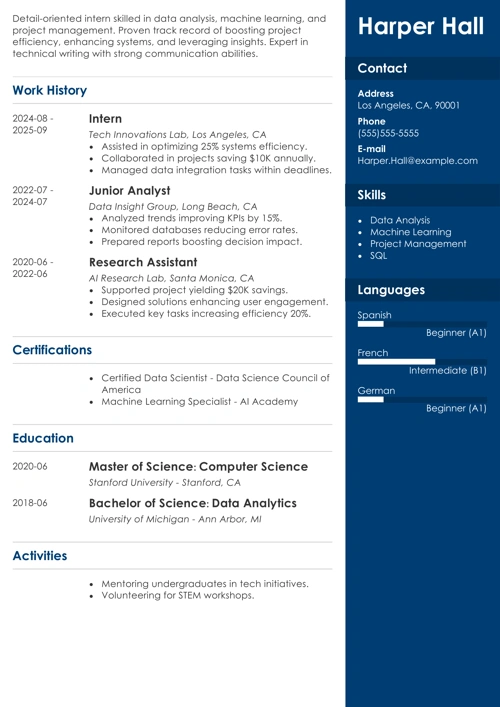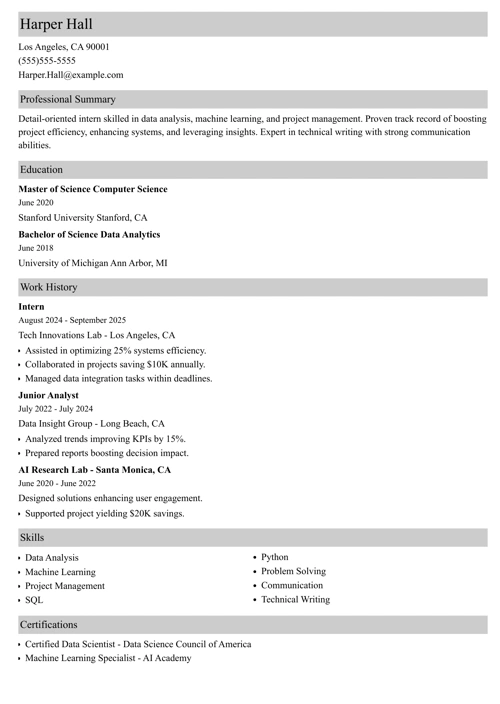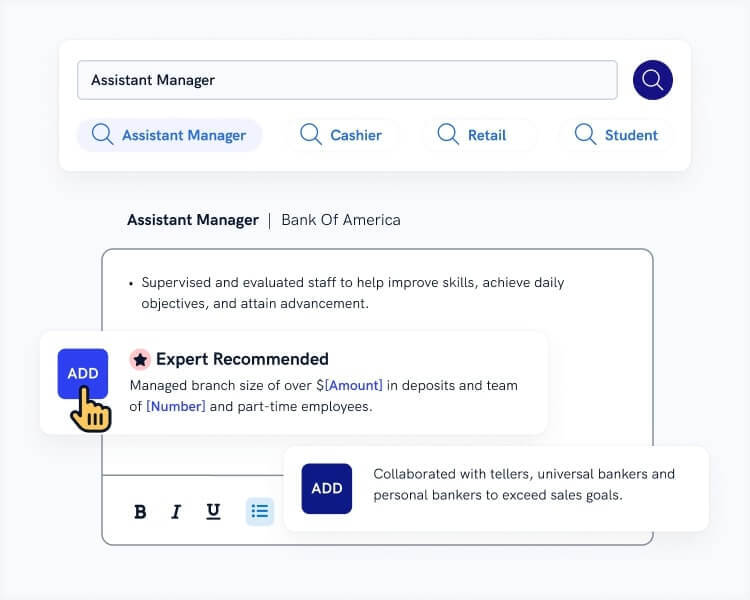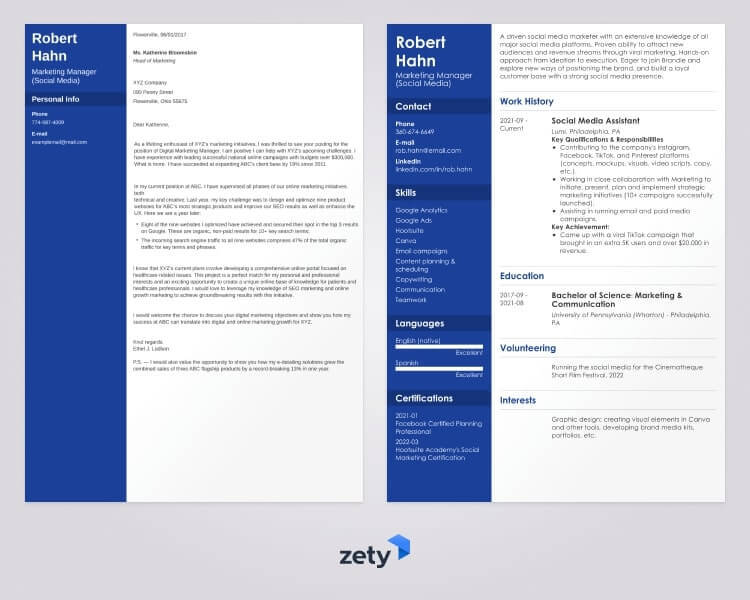Learning how to introduce yourself in an email is one of the best things you can do for your career. I'll show you everything you need to know about writing a self-introduction email, no matter if you're addressing a hiring manager or new colleagues at a job you're just starting out. Read on to discover the best tips and an introductory email template you can easily customize.
This guide will show you:
- A definition of a self-introduction email.
- How to introduce yourself in an email in 8 easy steps.
- Introduction email samples for different situations.
- A professional introduction email template you can use.
Want to save time and have your resume ready in 5 minutes? Try our resume builder. It’s fast and easy to use. Plus, you’ll get ready-made content to add with one click. See 20+ resume templates and create your resume here.
Sample resume made with our builder—See more resume examples here.
One of our users, Brittanya, had this to say:
Zety really helped me create the best resume possible. It pointed out how things could be better on my existing resume and suggested many things to be re-worded or removed.
Take a look at a selection of other helpful guides that may interest you:
- How to Introduce Yourself Professionally & Casually
- How to Write a Cover Letter Email
- Letter of Introduction: How Should You Write It?
- Popular Job Interview Questions & Answers
- Dear Hiring Manager Cover Letter Example & Expert Tips
- How to Start a Cover Letter [+ Cover Letter Introduction Samples]
- How Should You Answer: What Are Your Strengths and Weaknesses?
What Is a Self-Introduction Email?
A self-introduction email is a message sent to introduce oneself to a new or potential contact. The purpose of such an email is to establish a connection, often to discuss the possibility of collaboration or getting hired. A good introductory email should be brief but informative.
Remember: a successful introduction email goes beyond a single sentence or paragraph. It’s the entire message that counts. In a world where by 2026, people will be sending almost 400 billion emails per day, knowing how to make your self-introduction email stand out is crucial.
Read more: When writing a self-introduction email, this guide can be very useful: 100+ Words & Adjectives to Describe Yourself
How to Introduce Yourself in an Email
Knowing how to write an introduction email is valuable in today’s dynamic job market. It allows you to make a good first impression, which is essential, as first impressions are hard to change. Here’s how to introduce yourself in an email to someone you've never met in 8 easy steps:
1. Use an Attention-Grabbing Introduction Email Subject Line
Did you know that personalized subject lines can increase the email open rate by 50%? That’s a huge difference, so give your introductory email some love by unleashing your creativity and crafting an enticing subject line for your introduction email.
When writing your introduction email’s subject line, imagine yourself as the addressee: Would you be willing to open a message with this particular subject line? To increase your chances of catching the recruiter’s attention, keep your subject line concise, relevant, and professional. Here are a few strong examples:
Excited to Connect – [Your Name], Experienced [Your Profession]
Application Inquiry – [Job Title] Role at [Company Name]
Introduction: [Your Name] – Passionate [Industry] Professional Looking to Contribute
A well-written subject line makes your email stand out in a recruiter’s inbox, increasing the likelihood of a response. Keep it clear and engaging while showcasing your intent.
2. Start With a Personalized Greeting
To whom it may concern. Whoa! Let’s stop here before it gets worse. With an introduction like that, the only person concerned... would be yourself. Instead, aim to send your introductory email to a specific person.
Adjust the greeting to the industry your potential contact is working in. For example, in more traditional sectors, it’s safer to use a classic form, like “Dear.” But it doesn’t mean that “Dear Sir or Madam” is the best choice. It shows you don’t know who you’re writing to. Make an effort to identify your Dear Sir or Madam by name.
As I’ve mentioned before, research and address your self-introduction email to a specific person. Use their first name but skip their last name, as using both may make your greeting sound rather unnatural.
3. Mention Something Important for Them
This tip is also useful when working on your elevator pitch. You see, to truly catch somebody’s attention, you have to focus on them first, not yourself. So, do some research on your prospect and/or their company to come up with a perfect icebreaker.
For example, you can congratulate them on their recent win or express what you admire about the company. Whatever it is, make sure you’re being authentic and honest. And if you don’t know where to start your research, begin by taking a look at your prospect’s LinkedIn profile or the company website.
4. Say Why You’re Writing
Provide context for your email introduction and explain why you’re contacting them. Relevance is key. An introduction email that doesn’t resonate with the recipient will most likely go straight to the trash folder.
For example, if you’re writing an email introduction to a hiring manager, show them how they will benefit from hiring you. This is the most important part of your entire professional introduction email.
5. Finish With a Call to Action
You should always finish your professional introduction email with a clear call to action. A well-written one increases your chances of getting a response and achieving your goal of reaching out. Which CTA to use? If you’re writing to a recruiter, ask for an interview or a phone call.
6. Add a Professional Sign-off
Close your self-introduction email with a professional sign-off. You can opt for a classic “Sincerely” and your name. But before you finish your introduction email, be sure to thank your addressee for their time. Ending your self-introductory email with gratitude can boost your chances of getting a reply.
7. Proofread
Typos never make a good first impression. Take a moment to proofread your introduction email to ensure there are no errors. You can also use an online tool like for example, Grammarly.
Also, this may seem obvious, but double-check if your message starts with a subject line and ends with your name. Your “introduce yourself” email cannot be incomplete.
8. Follow Up
If you don’t hear back, don’t hesitate to send a follow-up email after a week or two. Refrain from showing any signs of impatience and maintain a professional and polite tone.
Start by courteously referencing your introduction email, succinctly reiterating your interest in the position or opportunity, and expressing your eagerness to discuss how you can contribute to the organization.
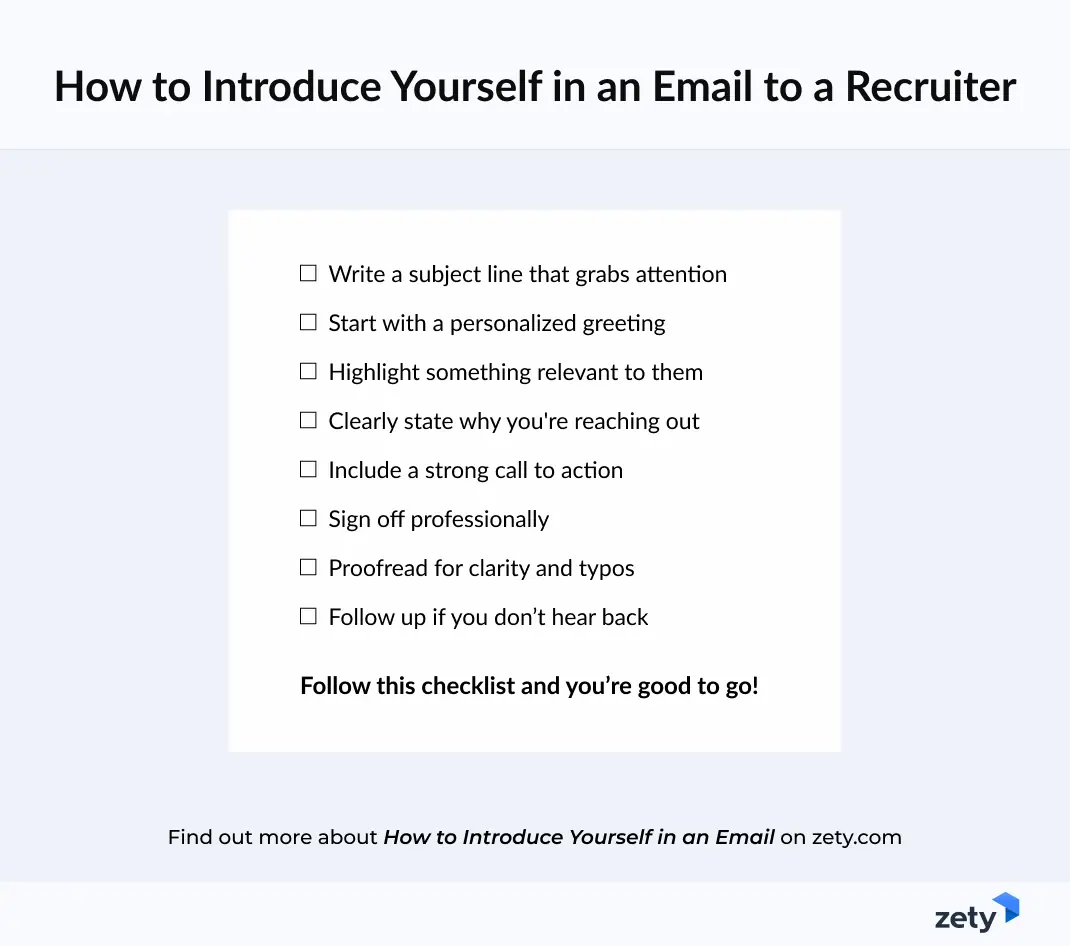
Read more: Not sure how to follow up? Let our guide clear your doubts: How to Follow Up on a Job Application
Creating a resume with our builder is incredibly simple. Follow our step-by-step guide and use content from Certified Professional Resume Writers to have a resume ready in minutes.
When you’re done, Zety’s resume builder will score your resume and our resume checker will tell you exactly how to make it better.
Introduction Email Samples
Just think about it: before you even get a chance to introduce yourself in an interview, you need to land one. In this day and age, sending a job application via email is the way to go. Check out the email introduction examples you can take inspiration from.
Sample Self-Introduction Email to a Hiring Manager
Take a look at this example of how to properly introduce yourself in an email to a recruiter.
Dear Adrian,
I’m writing with a keen interest in the Social Media Manager position at Innovative Solutions, spotted on LinkedIn. Your company's innovative approach to digital marketing, especially your campaigns for sustainable brands, truly resonates with me.
I am currently a Digital Marketer at Trending Now Media where I have successfully increased our client's social media engagement by over 50% in six months.
I’m eager to apply my skills in strategic content creation and analytics to help expand your digital footprint. Would you like to discuss how I can contribute to your team?
Thank you for considering my application.
Best regards,
[Your Full Name]
Sample Introduction Email to New Team
Here’s an example of how to introduce yourself in an email as a new employee:
Hi!
My name’s John. I’ve just joined the marketing department as an outreach specialist.
I’ll be getting in touch with influencers, bloggers, and vloggers to increase our online presence.
If you see a new face around, well, that’s me:) We can chat about cyberpunk literature, video games, and downhill mountain biking.
Cheers!
John
PS The sweet treats in the kitchen are all for you!
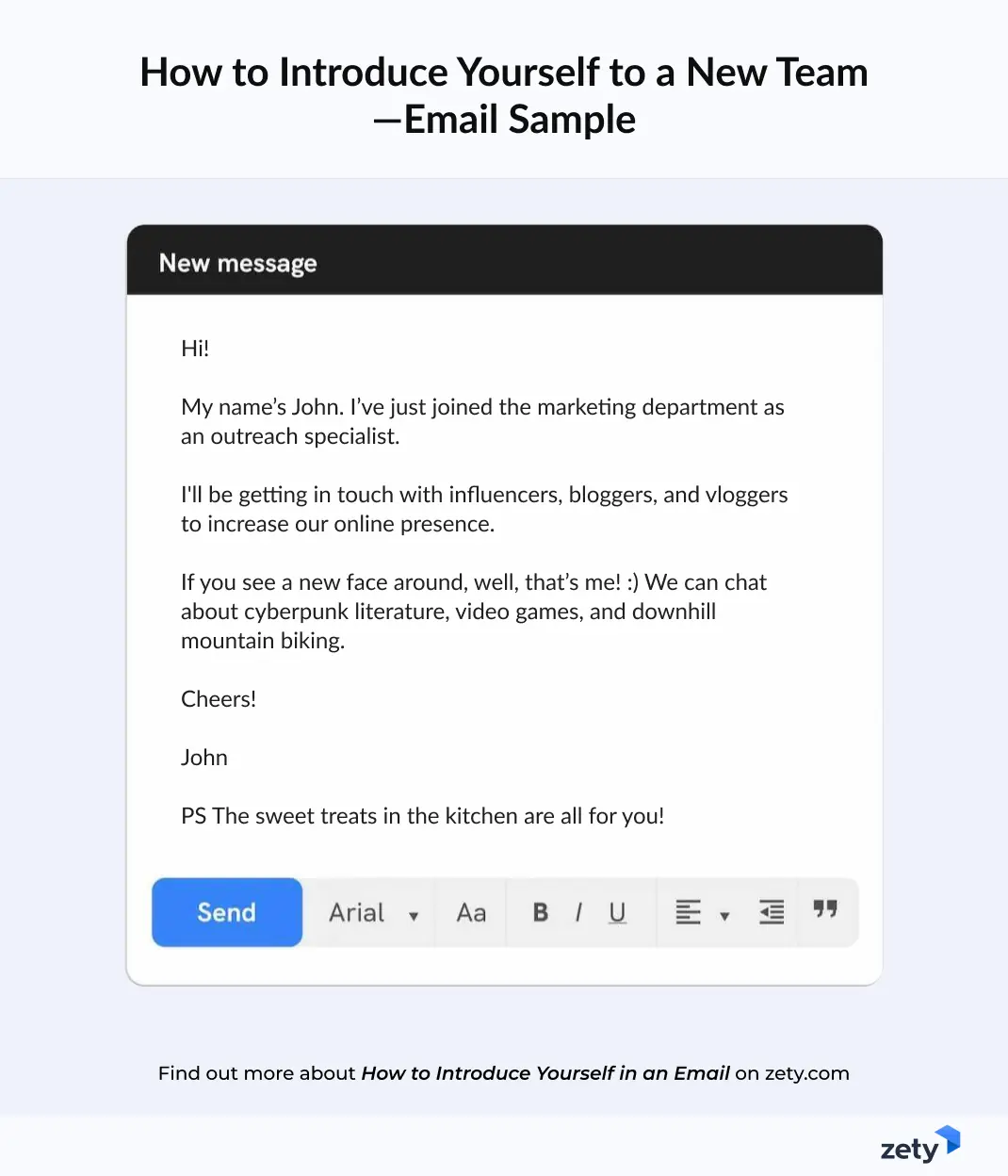
Pro Tip: You'll usually need to introduce yourself not only to the hiring manager but also in many other contexts, like to your new team, in the company newsletter, or on the website. Remember—understanding the context is key. If you’re having doubts, ask colleagues for examples of their introductions to gauge the expected length, structure, and tone. Plus, writing your introduction as if speaking to someone face-to-face in a professional setting is always a good idea.
Introduction Email Template
Next time you’ll be introducing yourself in an email, you can simply customize the self-introduction email template below:
Subject: [Main Topic or Opportunity]
Email:
Dear [Recipient's Name],
My name is [Your Full Name], and I recently came across your work in [specific field or project]. I am very impressed by [mention a specific aspect or achievement of the recipient or their company] and feel compelled to reach out.
I am contacting you today to [state your specific reason, such as inquire about a potential job opportunity, seek mentorship, propose a collaboration, etc.]. I believe that my background in [Your Field/Industry], coupled with my experience at [Your Company or Project], positions me well to add value to your [team, project, initiative].
I would appreciate the opportunity to discuss this further and explore ways we might work together. Please let me know if we could arrange a time for a brief conversation.
Thank you for your time and consideration.
Best regards,
[Your Name]
Plus, a great cover letter that matches your resume will give you an advantage over other candidates. You can write it in our cover letter builder here. Here's what it may look like:
See more cover letter templates and start writing.
Key Takeaways
Let’s sum up how to introduce yourself in an email:
- Craft a catchy subject line
- Begin with a tailored greeting
- Reference something relevant to the recipient
- Clarify the purpose of your email
- Demonstrate your value
- Conclude with a clear call to action
- Use a formal closure
- Review for errors
- Send a follow-up if necessary
About Zety’s Editorial Process
This article has been reviewed by our editorial team to make sure it follows Zety's editorial guidelines. We’re committed to sharing our expertise and giving you trustworthy career advice tailored to your needs. High-quality content is what brings over 40 million readers to our site every year. But we don't stop there. Our team conducts original research to understand the job market better, and we pride ourselves on being quoted by top universities and prime media outlets from around the world.
